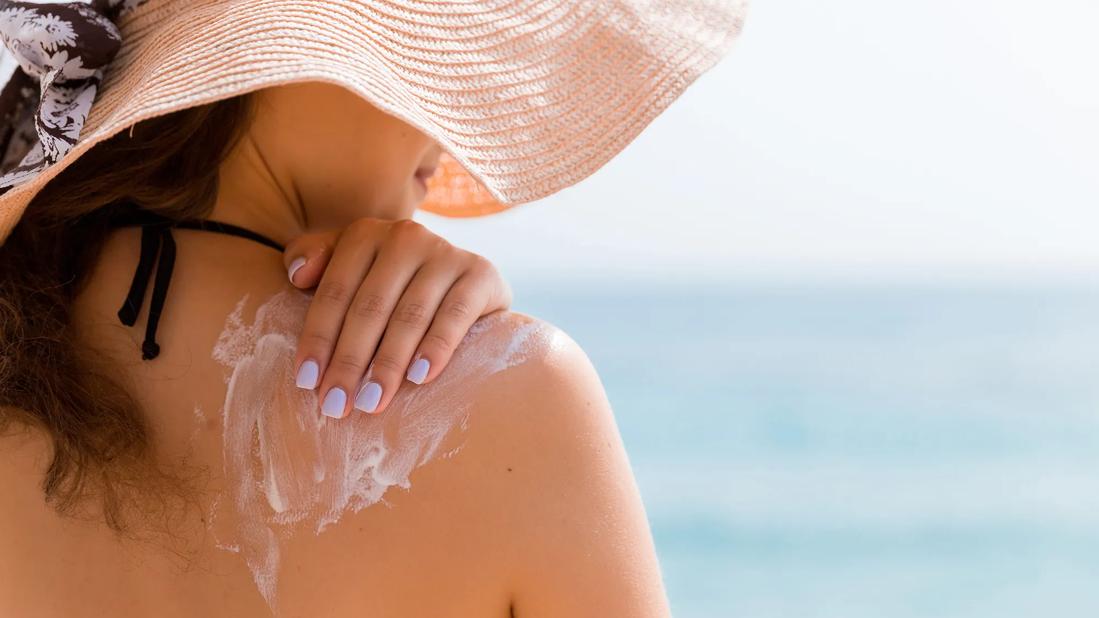You can still get a tan (a sign of skin damage) while wearing sunscreen

Here comes the sun! That warmth beaming down from the sky feels delightful — and the urge to soak up those rays may convince you to expose a little more skin than usual to get that sun-kissed glow.
Advertisement
Cleveland Clinic is a non-profit academic medical center. Advertising on our site helps support our mission. We do not endorse non-Cleveland Clinic products or services. Policy
But just as you’re tempted to skip sunscreen, your brain reminds you of some not-so-great consequences of that decision:
So, as you wisely slather on sunscreen, a question comes to mind: Will you get any color at all?
The answer: Probably.
To learn more, we asked dermatologist Amy Kassouf, MD, to share why your skin still darkens with sunscreen — and why that might not necessarily be a good thing.
You get a tan because sunscreen — even with the highest sun protection factor (SPF) — can’t block all ultraviolet (UV) light.
Two types of UV light can affect your skin: UVA and UVB.
UVA rays penetrate deep into your skin. These rays make you tan. But they can also make you burn. Damage from UVA rays can cause:
UVB rays mostly affect your skin’s top layer (epidermis). These rays cause sunburn. UVB rays also increase your risk for skin cancers, like melanoma.
SPF measures how long it takes UVB rays (and only UVB rays) to cause sunburn when wearing sunscreen versus going without.
Advertisement
As an example, sunscreen with an SPF of 30 blocks about 97% of the sun’s UVB rays. This means it should take 30 times longer for your skin to burn with this level of sunscreen than without it.
Of course, that’s assuming you apply enough sunscreen (most of us don’t). And that you hit all areas (most of us overlook certain body parts). And that you reapply frequently (another task that most of us fail).
Only broad-spectrum sunscreens protect against both UVB rays that cause sunburns and UVA rays that cause tanning. The higher the broad-spectrum SPF, the higher the UVA and UVB protection.
But even if you ace Sunscreen Application 101, some rays still affect your skin. “You’ll still tan or burn with sunscreen,” states Dr. Kassouf. “But skin damage occurs more slowly.”
Yes. Regardless of whether you wear sunscreen, a suntan is a sign of skin damage. And this damage is permanent.
“When you expose your skin to the sun, melanocyte cells in your body make more melanin [a pigment in skin, hair and eyes] to protect against burning,” says Dr. Kassouf. “This increase in melanin causes skin to darken into a tan.”
Yes. Even if you have a tan, you should wear sunscreen anytime you’re exposed to UV light because it’s still possible to get too much UV exposure and develop a sunburn.
Plus, certain medications can make your skin more sensitive to the sun’s rays.
Applying sunscreen every day — whether you’re headed to the beach or the office — is the best way to lower your risk of skin cancer, sunburn and wrinkles. This sunscreen rule applies equally to people of color, who can also experience the harmful effects of UV radiation, including skin cancer and hyperpigmentation.
The two main types of sunscreen — mineral and chemical — protect your skin in slightly different ways:
No. A review of studies found no link between sunscreen use and vitamin D deficiency — which is good news. That’s because your body needs vitamin D for strong bones and a healthy immune system.
Your body makes vitamin D by absorbing UVB rays, which (as we mentioned) still get through even when you wear sunscreen. You don’t need to allow even more to get through by skipping the sunscreen.
If you’re concerned about a vitamin D deficiency, foods and supplements are safer ways to get the nutrient without putting yourself at risk for skin cancer, says Dr. Kassouf.
Advertisement
To prevent suntans and sunburns, follow these steps when applying sunscreen:
These skin-protective tips can also help lower your risk of sun damage:
While you might like the way your skin looks when it darkens, there’s no such thing as a safe or healthy tan from sun exposure.
“If you really want to look tan, try self-tanning products,” advises Dr. Kassouf.
Spray tans are another option, although the chemicals can trigger skin irritation or allergic reactions. It’s also important not to inhale the chemicals during your tanning session.
But whatever you do, skip tanning beds, which expose you to 10 times more UVA rays than the sun. And say no to tanning pills and nasal tanning sprays, which can pose significant health risks.
Advertisement
Learn more about our editorial process.
Advertisement

Several conditions, like vitiligo and fungal infection, can cause a loss of pigmentation, leading to white spots or patches on your skin

This cooling gel can help soothe sunburned skin, but it can’t cure the burn

You know it’s not good if you’ve been holding onto it for more than three years or if it’s changed in color, consistency or smell

Look for a UPF rating of 50+ for optimal protection against UV rays

A sunburn will leave you itchy and red, while sun poisoning can feel like an allergic reaction

A cool shower, aloe vera gel, anti-itch treatments and cool compresses can provide fast sunburn relief

SPF stands for ‘sun protection factor’ — it’s a measure of how much protection you’re getting before a sunburn is possible

This ‘poisoning’ is actually a severe sunburn that seems similar to an allergic reaction

Babies can get congested easily, but you can calm their cough by keeping them hydrated, using nasal drops and running a humidifier

Weight loss may cause loose, sagging skin and muscle loss to your rear

Several conditions, like vitiligo and fungal infection, can cause a loss of pigmentation, leading to white spots or patches on your skin